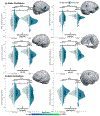Chronic cannabis use differentially modulates neural oscillations serving the manipulate versus maintain components of working memory processing
- PMID: 39765275
- PMCID: PMC11798582
- DOI: 10.1016/j.nbd.2025.106792
Chronic cannabis use differentially modulates neural oscillations serving the manipulate versus maintain components of working memory processing
Abstract
The legalization of recreational cannabis use has expanded the availability of this psychoactive substance in the United States. Research has shown that chronic cannabis use is associated with altered working memory function, however, the brain areas and neural dynamics underlying these affects remain poorly understood. In this study, we leveraged magnetoencephalography (MEG) to investigate neurophysiological activity in 45 participants (22 heavy cannabis users) during a numerical WM task, whereby participants were asked to either maintain or manipulate (i.e., rearrange in ascending order) a group of visually presented numbers. Significant oscillatory responses were imaged using a beamformer and subjected to whole-brain ANOVAs. Notably, we found that cannabis users exhibited significantly weaker alpha oscillations in superior parietal, occipital, and other regions during the encoding phase relative to nonusers. Interestingly, during the maintenance phase, there was a group-by-condition interaction in the right inferior frontal gyrus, left prefrontal, parietal, and other regions, such that cannabis users exhibited weaker alpha and beta oscillations relative to nonusers during maintain trials. Additionally, chronic cannabis users exhibited stronger alpha and beta maintenance responses in these same brain regions and prolonged reaction times during manipulate relative to maintain trials, while no such differences were found in nonusers. Neurobehavioral relationships were also detected in the prefrontal cortices of nonusers, but not cannabis users. In sum, chronic cannabis users exhibit weaker neural oscillations during working memory encoding but may compensate for these deficiencies through stronger oscillatory responses during memory maintenance, especially during strenuous tasks such as manipulating the to-be remembered items.
Keywords: MEG; Magnetoencephalography; Marijuana; Short-term memory; Substance use; cannabis use disorder.
Copyright © 2025 The Authors. Published by Elsevier Inc. All rights reserved.
Conflict of interest statement
Declaration of competing interest The authors of this manuscript acknowledged no conflicts of interest, financial or otherwise.
Figures





Similar articles
-
The neural oscillations serving task switching are altered in cannabis users.J Psychopharmacol. 2024 May;38(5):471-480. doi: 10.1177/02698811241235204. Epub 2024 Feb 28. J Psychopharmacol. 2024. PMID: 38418434 Free PMC article.
-
Chronic Cannabis users exhibit altered oscillatory dynamics and functional connectivity serving visuospatial processing.J Psychopharmacol. 2024 Aug;38(8):724-734. doi: 10.1177/02698811241265764. Epub 2024 Aug 1. J Psychopharmacol. 2024. PMID: 39087306 Free PMC article.
-
Chronic cannabis use alters the spontaneous and oscillatory gamma dynamics serving cognitive control.Hum Brain Mapp. 2024 Aug 1;45(11):e26787. doi: 10.1002/hbm.26787. Hum Brain Mapp. 2024. PMID: 39023178 Free PMC article.
-
Altered Functional Connectivity Dynamics Serving Cognitive Flexibility in Regular Cannabis Users.Addict Biol. 2025 Feb;30(3):e70023. doi: 10.1111/adb.70023. Addict Biol. 2025. PMID: 40042248 Free PMC article.
-
Regular cannabis use modulates gamma activity in brain regions serving motor control.J Psychopharmacol. 2024 Nov;38(11):949-960. doi: 10.1177/02698811241268876. Epub 2024 Aug 14. J Psychopharmacol. 2024. PMID: 39140179
Cited by
-
Cognitive interference elicits developmental sex differences in inhibitory control.Dev Cogn Neurosci. 2025 Aug;74:101590. doi: 10.1016/j.dcn.2025.101590. Epub 2025 Jun 25. Dev Cogn Neurosci. 2025. PMID: 40582224 Free PMC article.
References
MeSH terms
Grants and funding
LinkOut - more resources
Full Text Sources
Medical

